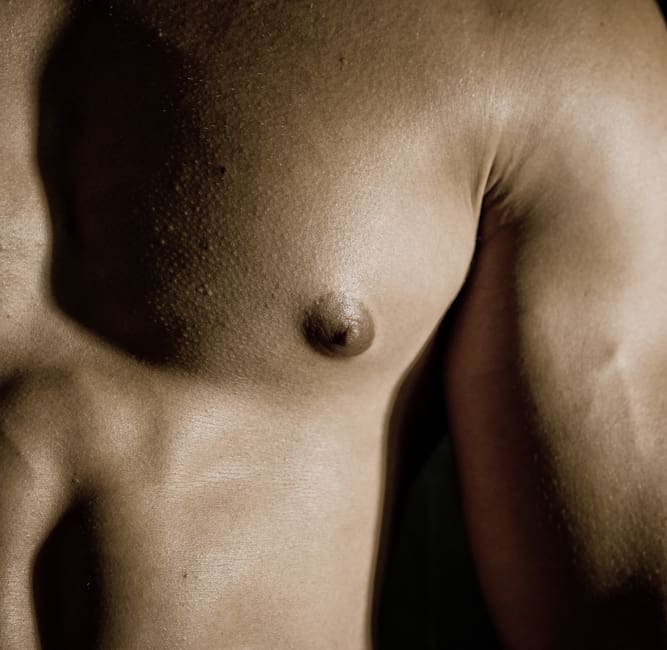Gynaecomastia
Gynaecomastia – causes and cure
Gynaecomastia. ‘Gynaeco-what?!’ Also known as enlarged chest or, more specifically enlarged breast glands, in men. We are not talking about ‘pecs’ that men aspire to and work hard towards in the gym; but a medical condition that can cause a considerable amount of discomfort and loss of confidence.

Here we will explore the condition, the possible causes and treatment options. Many men suffer in silence, as it’s not something that is talked about often or openly; we want to break that silence and start the conversation. Many are not aware that their condition can be corrected with a straightforward procedure under local anaesthetic and they can be in and out of the clinic within two hours. Even though you may not have heard of the medical name for the condition, chances are you know at least one or two people affected by it, as it is fairly common.
So let’s start with looking at the symptoms and potential causes:
Symptoms:
Put simply, Gynaecomastia is an enlargement of the gland or extra tissue in the surrounding area causing a protrusion and it affects one side or both. Sometimes it can be accompanied by pain, but this is not always the case. The discomfort tends to be more on the emotional/psychological level considering the physical impact of this condition
Hormones/Health conditions
Hormones play a major part: an imbalance between the sex hormones testosterone and oestrogen can result in growth of the breast glands in men, or, more specifically, a drop in testosterone levels. Sometimes, the cause of this imbalance is not known.
Teenage boys are often diagnosed with the condition also, again due to the havoc that hormones can wreak during puberty.
But there can be other reasons for hormonal imbalance such as liver or testicular disease and in very rare cases cancer can cause Gynaecomastia. Hence it is important to make your GP your first point of call to rule out any other health conditions before considering cosmetic surgery. Breast cancer in men is rare and occurs in only 1% of cases. Male breast enlargement and Gynaecomastia itself is usually a benign (noncancerous) condition.
In rare cases, gynaecomastia can be caused by:
1. Side effects of some medication. These may include but as not limited to anti-ulcer drugs or heart disease medication
2. Drug use – most commonly cannabis or anabolic steroids (the link between steroid use and Gynaecomastia is relatively well-known)
3. Alcohol in large amounts
4. Other slightly less common health disorders such as Klinefelter’s syndrome
Weight gain/Obesity:
Breast enlargement in men can also be caused by an accumulation of fatty tissue, due to weight gain or obesity – referred to as ‘pseudo gynaecomastia’ – and the treatment in this case differs. Losing weight or doing more exercise may only improve the condition if excess fatty tissue is the cause. One should be aware that obesity may increase levels of oestrogen, causing breast tissue to grow abnormally. Your GP or specialist should be able to advise you on this.
Age
As mentioned before many teenage boys have some degree of breast enlargement, but this generally clears up as with age and as their hormone levels normalise
Surprisingly, Gynaecomastia can also temporarily affect new-born baby boys, because of the oestrogen passing through the placenta from the mother to the baby. This will disappear a few weeks after birth
As men get older, testosterone levels tend to drop. This is combined with the fact that older men tend to have higher amounts of body fat, causing more oestrogen to be produced, as is the case with obesity.
Treatment Options
For those of you with this condition, questions may arise at this stage: ‘What is the next step? What are the options for treatment? Which one is suitable for me?
First it is important to note that there are different stages of gynaecomastia and therefore treatment options vary accordingly. For example if the condition first develops during puberty, you may be advised to wait up to two years to allow for the potential – and likely – natural regression of the breast tissue. Seeing your GP would be the first step to check the potential cause and get checked up. Medication may be prescribed to shrink the glands. In the case of mild pseudo-gynaecomastia, losing weight may help. Another, or perhaps, the next option is to book in for a consultation with a cosmetic surgeon who offers gynaecomastia surgery as a treatment. Depending on the cause there are chances of regression without surgical intervention. This surgery is not generally available on the NHS.
Surgery: Minimally invasive Vaser Liposuction, using ultrasound technology to remove the fatty tissue and/or surgical gland removal, which involves making a small incision on the side or in the middle of the breast, are the methods used to treat gynaecomastia surgically. The method is chosen according to the stage of the Gynaecomastia, the preference of the patient and the type of tissue to be removed. Both are generally performed under local anaesthetic but sedation is also an option. All this will be discussed and agreed with your doctor prior to treatment. The procedure duration ranges from 1 to 2 hours approximately with a recovery of 1-2 weeks. The associated pain and scarring are minimal.
Click here to read patient reviews and testimonials for our team!

-






